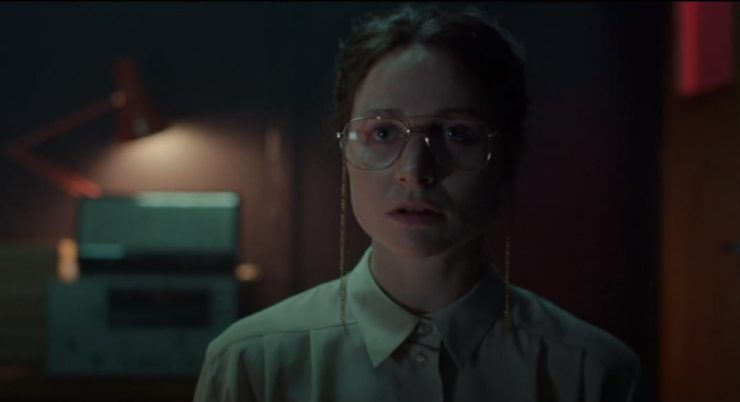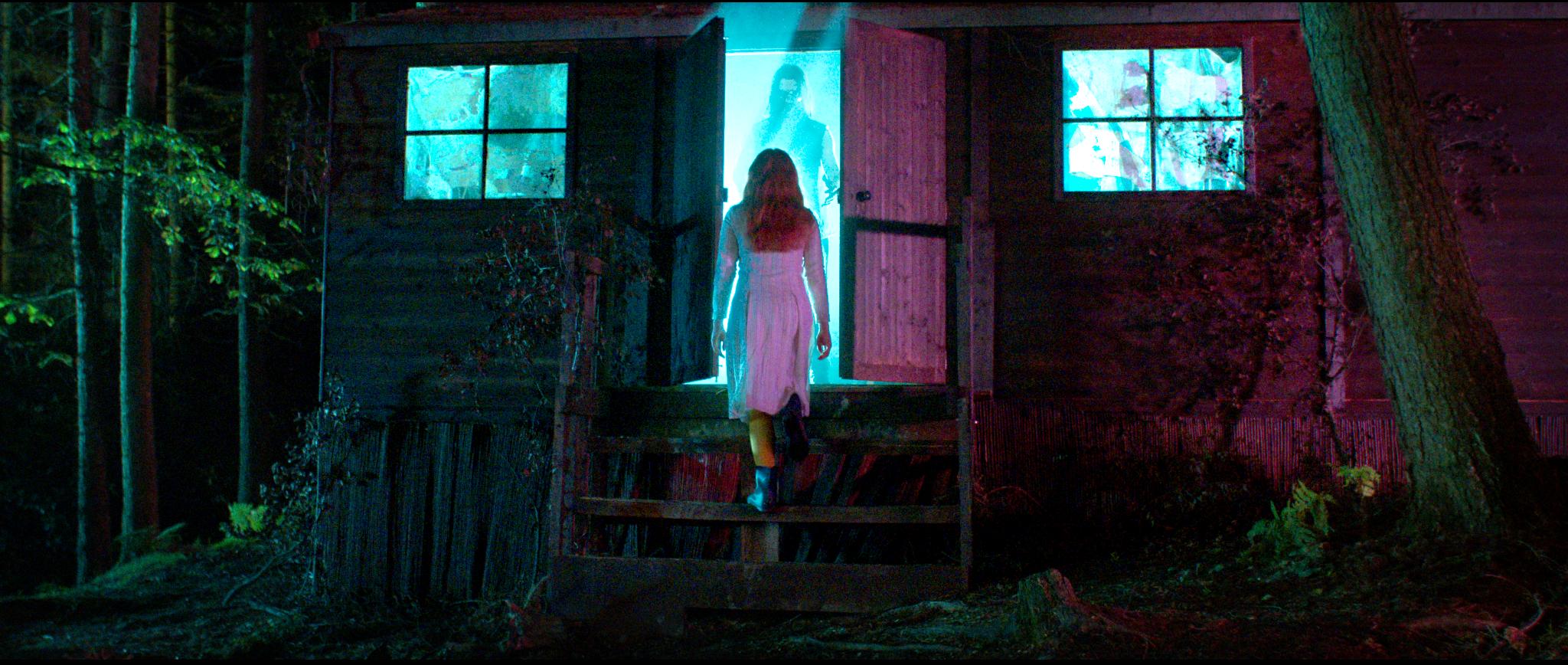This website uses cookies so that we can provide you with the best user experience possible. Cookie information is stored in your browser and performs functions such as recognising you when you return to our website and helping our team to understand which sections of the website you find most interesting and useful.

Censor: The Whole Story
We asked Aberystwyth born Director Prano Bailey-Bond to sit down with a real life film censor from the British Board of Film Classification (BBFC) to discuss her critically acclaimed horror film, which released UK wide on August 20th.
Thanks to Fedor Tot for leading this conversation.
Censor is the latest in a thriving line of homegrown British horror films of the past decade, built by a small coterie of blood-spattered cinephiles: Saint Maud (dir: Rose Glass), His House (dir: Remi Weekes), the works of Ben Wheatley and Peter Strickland.
This group of directors have collectively used horror underpinnings to get underneath the skin of contemporary life in varied and often singular ways. Directed by Aberystwyth-born Prano Bailey-Bond, Censor follows firmly in these footsteps. The film uses its horror framework to dissect the human psyche’s ability to suppress and forget traumatic memories, tying itself into a wider impulse to protect and regulate moral sensitivities. It’s set in a censor’s office in 80s Britain, inspired by the furore of the video nasties scare in the 80s, where amoral panic around the availability of violent horrors on VHS saw a number of films banned from in the UK.
Our protagonist Enid (Niamh Algar) is tasked with watching video nasties and judging which ones pass and which don’t. One day, she comes across a film she believes features her long-lost sister, who disappeared when the two were still kids. This then pulls Enid into a downward spiral as she attempts to seek out the film’s makers and find answers to her traumatic childhood, whilst her own grip on reality disintegrates.
The UK’s own relationship with film censorship has historically taken place on moralistic grounds: most of the films cut or banned by the BBFC (initially called the British Board of Film Censorship, but the C has stood for Classification since 1985) during the video nasties era were done so on the basis of gratuitous violence or sex. The BBFC broadly takes a more hands-off approach these days, with very few films outright refused classification today. Sarah Peacock, Compliance and Education Manager at the BBFC, talks about the shift in perspective from censorship to classification: “we’re very much here to inform and empower people, particularly parents of younger children to make positive viewing choices.”
Any actual cuts or refusals of classification these days tend to be focused around specific pieces of legislation, such as animal cruelty laws. It’s fundamental to the ethos of the BBFC that “adults should be free to choose their own entertainment… It really is the last resort for anyone involved to have to cut something. We’re all film fans, we don’t want to do that.”
The film itself was made with a good deal of help from the BBFC, with Bailey-Bond allowed access to the notes of those working and watching films at the BBFC back in the ‘80s.
“We booked out the files on things like The Texas Chain Saw Massacre, The Last House On The Left, The Evil Dead, and we were able to read the comments that were being made.I could spend hours with those files. You start to get a real feel for the different personalities of the film examiners, even though I think on most of them, they’re just their initials. You don’t even get to know their names. But you can start to recognise certain initials and say ‘oh, that person’s very focused on violence towards women’, or ‘this person is slightly more lenient and this person’s very strict.’
Crucially though, Censor doesn’t name the BBFC. Rather, it takes place in an unnamed censor’s office to avoid having to tie up the film too specifically in historical accuracy. It also allows for Bailey-Bond to have some fun by crafting a number of mini fictional video nasties within the film, rather than relying on the films actually affected. Bailey-Bond certainly has plenty of stylistic tricks up her sleeve: the film shifts between widescreen and the boxy 4:3 aspect ratio you expect of VHS tapes, with scuzz and snow left on the screen. Much of the film was shot on 35mm, with a few sections in digital:
“the texture of the film was a really important aspect for me…it was fun talking to people who remember the second-, third-, fourth-generation copies of these films who were doing fanzines and sending these films illegally around the country. The films would get more degraded with each copy, but also the really horror-y bits would be rewound and rewatched over and over again, so they’d be even more snowy and fuzzy. In some ways, it hides the bad special effects for some films, but also [you get this] dirty feeling that something bad is coming.”
The media-mixing plays well into the film’s melding themes of memory, trauma, and disconnection from reality. Censor is a much cooler, icier film than many a video nasty. One of its biggest onscreen ancestors is undoubtedly Andrzej Żuławski’s Possession, itself banned at the time, with both films sharing a surreal, distorted viewpoint – albeit not an atmosphere one generally associates with the grime and splatter of many other banned films of that era. Why did Bailey-Bond opt to go in this direction? “The film was like a weaving of fiction, reality, dreams and memory. And I like slightly surreal cinema. I wanted to make it feel smooth, sort of woozy and like a dream, so that we were able to be with Enid and be in her head. I think if it was a full-on splatter fest, I wouldn’t be able to meditate with Enid as much and that was always my intention. Just because it’s about video nasties, it doesn’t have to be a video nasty.”

Censor is evidence of the horror genre’s own ever-changing relationship to its past, mashing in what was a defining moment for British horror fans of the ‘80s with its own female-centred worldview and contemporary concerns about the veracity of the content we consume. In conjunction with that is the realisation that the BBFC’s relationship with filmgoers is too, also always changing, something borne out by their process of running regular consultations with audiences. These consultations give us an idea of how societal attitudes change over time – cultural responses to onscreen material haven’t become increasingly liberal in a linear fashion.
Racism, sexual threats and violence (implied or explicit) and discrimination are all more likely to be classified at higher age ratings now, whilst a lot of video nasties are today passed uncut – generalised violence seems a lot less likely to shock. Intriguingly, recent consultations with teenagers and young adult groups have revealed a lot of anxiety around ‘real world threats’, what Sarah Peacock describes as “things that could happen to me”.
“So issues around terrorism or abduction, kidnapping, natural-disaster-type films. There’s an increasing anxiety around these films at the 12-15 age rating borderline”. Cinema has always grappled with the dividing line between what horrors the real world can throw at us versus the deepest, darkest recesses of our own psyche, something which Censor is intimately concerned with.
And yet, perhaps the real fears for audiences lie in an increasingly unstable world, approaching (or already fully enveloped in) climate breakdown and a sense of a lack of control over the events of our daily lives. In a twist of fate, horror stories start to look more like escape into our subconscious, a journey into the unknown to discover what lurks beneath.





